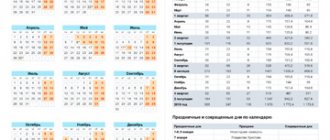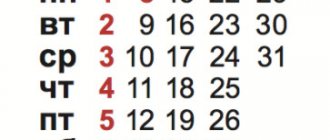Many enterprises regard absenteeism as a gross violation of the internal regulations of work and rest.
This offense is accompanied by a disciplinary sanction; isolated situations may lead to the termination of the employment contract with the offending employee.
Truancy
Absenteeism may become one of the grounds for terminating an employment agreement at the request of the employer.
Absenteeism is the absence of an employee from his assigned place without a satisfactory reason for 4 or more hours in a row during one day (shift). Nothing depends on the length of the shift (the employee skipped working hours). The boss can define the following points as absenteeism:
- When an employee who has signed an employment contract (term unspecified) leaves his workplace without satisfactory reason, without notifying the employer of termination of the agreement, before the expiration of the 2 week notice period;
- When an employee who has signed a contract (fixed term) leaves the position without any valid reason before the expiration of the contract or before the expiration of the warning period for early termination;
- Self-management of days off, as well as arbitrary assignment of vacation.
These norms may seem to be clearly defined and extremely transparent. However, employers, and often the courts, even today find themselves at a dead end when studying such cases and determining whether a particular situation constitutes truancy. As a result, judges' verdicts often turn out to be incorrect and hasty.
Corrective accounting sheet
When employee absenteeism has been identified, you need to draw up a corrective report card. Then, if disputes arise, the boss will be able to easily prove the fact that he was not at work. Certain standards must be adhered to:
Mark absenteeism correctly
It is important, when a person stops regularly appearing at the workplace, not to miss the designations “NN” or “30”. These encodings indicate the fact that the employee was absent due to unknown circumstances. They can also be used if you are late or leave before the end of your shift. Then you can charge less money for shortcomings. But do not forget to mark the hours that were worked.
Accounting for weekends
Even during absenteeism, weekends determined by a person’s individual schedule must be marked with the coding “B” or “26”. The employee cannot appear on these days; they are considered non-working days. In one of the trials, the court negatively assessed the report card, which included only “NN”. The fact is that in recording the time of other employees, everything was filled out in accordance with established standards.
TIN code
We set the TIN code until the reason why the employee is not in his assigned place is clarified. Direct evidence of absenteeism in the time sheet is marked “NN” or “30”. They are able to guarantee the employer a positive outcome of the trial.
It is worth mentioning that the court does not focus on the type of report card. She is not interested in whether the employer uses an individual form, Form No. T-12 or No. T-13. It is important that he regularly notes work time and controls accounting. In fact, the form of the report card itself does not affect working rights (determined by the Moscow Regional Court).
Symbols in the time sheet in 2021
The report card can use alphabetic or numeric codes to indicate a particular event, for example, attendance at work has the letter I or 01 in digital expression, absenteeism - PR or 24, additional days off without pay - NV or 28.
You can find the required code using the table.
Timesheet codes (2020) - a complete list of alphabetic and numeric characters - are contained on the first page of Form T-12.
| Code | ||
| alphabetic | digital | |
| Duration of work during the day | I | 01 |
| Duration of work at night | N | 02 |
| Duration of work on weekends and non-working holidays | RV | 03 |
| Overtime duration | WITH | 04 |
| Duration of work on a rotational basis | VM | 05 |
| Business trip | TO | 06 |
| Advanced training without work | PC | 07 |
| Advanced training with a break from work in another area | PM | 08 |
| Annual basic paid leave | FROM | 09 |
| Annual additional paid leave | OD | 10 |
| Additional leave in connection with training while maintaining average earnings for employees combining work with training | U | 11 |
| Reduced working hours for on-the-job trainees with partial pay retention | UV | 12 |
| Additional leave in connection with training without pay | UD | 13 |
| Maternity leave (leave in connection with the adoption of a newborn child) | R | 14 |
| Parental leave until the child reaches the age of three | coolant | 15 |
| Unpaid leave granted to an employee with the permission of the employer | BEFORE | 16 |
| Leave without pay under the conditions provided for by the current legislation of the Russian Federation | OZ | 17 |
| Additional annual leave without pay | DB | 18 |
| Temporary disability (except for cases provided for by code “T”) with the assignment of benefits in accordance with the law | B | 19 |
| Temporary disability without benefits in cases provided for by law | T | 20 |
| Reduced working hours versus normal working hours in cases provided for by law | Champions League | 21 |
| Time of forced absence in the event of dismissal, transfer to another job or suspension from work being declared illegal, with reinstatement to the previous job | PV | 22 |
| Absenteeism while performing state or public duties in accordance with the law | G | 23 |
| Absenteeism (absence from the workplace without good reason for the time established by law) | ETC | 24 |
| Duration of part-time work at the initiative of the employer in cases provided for by law | NS | 25 |
| Weekends (weekly vacation) and non-working holidays | IN | 26 |
| Additional days off (paid) | OB | 27 |
| Additional days off (without pay) | NV | 28 |
| Strike (under conditions and in the manner prescribed by law) | ZB | 29 |
| Absences for unknown reasons (until the circumstances are clarified) | NN | 30 |
| Downtime caused by the employer | RP | 31 |
| Downtime due to reasons beyond the control of the employer and employee | NP | 32 |
| Downtime due to employee fault | VP | 33 |
| Suspension from work (preclusion from work) with payment (benefits) in accordance with the law | BUT | 34 |
| Suspension from work (preclusion from work) for reasons provided for by law, without accrual of wages | NB | 35 |
| Time of suspension of work in case of delay in payment of wages | NZ | 36 |
unified form T-12
It should be noted that the unified form T-12 can be used in any organization, regardless of the form of ownership, except for budgetary institutions.
In budgetary institutions, an accounting form is used, approved by order of the Ministry of Finance of Russia dated March 30, 2015 No. 52n, which uses other digital and letter designations in the working time sheet.
Change data in a timely manner
Until the reason for the employee’s failure to appear at his place has been determined, do not mark the time sheet with the coding “PR” or “24”. First, you should make sure that there are no positive justifying factors for all days. In the beginning, it is worth demanding an explanatory statement from the employee, then the boss can draw up a decree imposing a penalty. Although the employee will not challenge termination due to absenteeism, if the employer immediately leaves the mark “PR” instead of “NN”. In court, the evidence base (failure to appear) is important, and not this moment of registration.
When the fact of absenteeism becomes undeniable, write an adjustment document for this person. This is an additional document issued with the code “NN”. It is compiled for the current day, but for the entire period of absenteeism. In this report card, the encoding “PR” will be correct.” If on some days the employee is able to bring documents justifying absenteeism, then it is worth entering this data into the accounting document under the necessary codes. For example, you can leave the notes “B” or “T” if the reason for failure to appear was disability.
You cannot make adjustments to a timesheet that has already been taken into account by the accounting department. The first reason is that the document will be unreadable due to the large number of corrections. The boss will need to cross out the notes, add new ones, indicate the date of the adjustments, and certify them. Also, at the time of filling out the report card corresponded to the real situation. And it will clearly demonstrate that the person was not at his workplace. The last reason is that for accounting there is no difference between the designations “NN” or “PR”. All that matters to them is that the employee does not have the right to receive money for these hours. It turns out that everything will be correct with the calculations.
Absence from work: designation on the report card
According to paragraph 6 of Art. 81 of the Labor Code of the Russian Federation, absenteeism is the absence of an employee from the workplace for more than 4 hours in a row (or throughout the entire working day) without good reason. Even for a one-time violation of this kind, the employer has the right to dismiss the negligent employee, and in the best case, reprimand or reprimand him. At the same time, it is important that the necessary procedure for registering absenteeism is followed in accordance with labor legislation.
The timesheet (usually the T-12 or T-13 form is used) reflects the time actually worked by each employee, as well as periods of absence from work for various reasons (illness, vacation, business trip, etc.). For each such reason, its own designations are provided - alphabetic or digital. So, for absenteeism the designation “PR” or the digital code “24” is used.
In the case where the employee is absent and does not make himself known for four or more hours, there is no need to rush to put it down. It is possible that after some time, the reason for absence will become clear, which management will consider valid. For example, when an employee, upon leaving home, was “stuck” for several hours in the elevator due to its breakdown, and could not reach the employer by phone, because... There is often no mobile connection. Such “force majeure” may well be confirmed by documented certificates from the relevant utility and repair services.
In the meantime, the circumstances of the absence are unknown, it must be marked on the report card with the symbol “NN” (or “30”), which means failure to appear for unknown reasons. If later the employee presents, for example, sick leave for the missed days, this code should be corrected to the temporary disability code - “B” or “19”.
Thus, before entering absenteeism on the report card, you need to obtain confirmation that the absence was due to an unexcused reason, and the employee provided an appropriate explanation (or refused to explain what the report was drawn up).
If the absenteeism did not last a full working day or shift, the report card indicates both the absenteeism and partial attendance at work. For example, 5 hours of absenteeism in the morning without a valid reason, after which the employee reported to his workplace, will be indicated in the corresponding cells of the timesheet as “PR/I”, and hours of absence and actual work - “5 / 3”.
Why is this necessary?
- So that managers and employees remember that their colleague is currently on vacation and take this into account in their own and production plans.
- So that the employee soberly calculates his strength and closes as much as possible before the vacation or transfers all his unfinished cases to other employees of the department, reports on time and reports to his immediate supervisor.
- So that a few days before the start of the vacation, the employee is not added new tasks, cases or assignments that he cannot complete for objective reasons, but they are evenly distributed among other employees.
- So that managers can plan vacations for their employees throughout the year without compromising production interests.
- To minimize the factor of human error and simple forgetfulness.
Are you tired
You may be tired both physically and mentally. No one is immune from the fact that you will have the honor of unloading a car full of some nonsense for half a day at work, or you will fail a chemistry test. As practice shows, 92% of injuries during training are due to inattention, absent-mindedness and physical exhaustion. Therefore, your fatigue will certainly lead, at best, to a sprained or nailed dumbbell finger. When you are really tired, it is better to postpone the workout to the next day.
When you are sick or have a fever
Everything seems to be clear here. If you are sick, stay at home. Your zeal will not end well. Any strength and aerobic exercise will lead you to incurable diseases of the cardiovascular system. In addition, if you come to the hall even slightly snotty, you will infect all your colleagues in the iron shop. After all, our gyms are rather cramped places, and there are always problems with ventilation in them. If one sneezed, tomorrow everyone came down with the flu.
Who should keep track of working hours and who should be responsible for it?
If the organization is small, one person can keep time records.
If the structure of the enterprise is significant, it is advisable to appoint a responsible person in each division.
All responsible persons, regardless of their number, are appointed by orders for the main activities in order to avoid various kinds of misunderstandings.
Responsibility for the completeness and correctness of filling out the timesheet lies with the person authorized by the order.
The head of the department is responsible for the timely submission of timesheets to the accounting department.
The employer is responsible for everyone.
conclusions
Absenteeism is an employee’s misconduct, for which he can pay with his job.
The employer can also show leniency by issuing a reprimand, reprimand, or even not applying any punishment to the offending subordinate.
Violation of labor regulations must be documented, otherwise the enterprise will not be able to prove its case in a judicial body.
Before making a decision on imposing disciplinary action, the employer needs to find out whether the deadline for this action has expired. This type of dismissal must adhere to the provisions of Art. 193 Labor Code of the Russian Federation. Collection is allowed no later than 30 days from the date of discovery of the misconduct; the employee’s time of illness or vacation is not taken into account.
Didn't find the answer to your question in the article?
Get instructions on how to solve your specific problem. Call now:
+7 ext.445 — Moscow — CALL
+7 ext.394 — St. Petersburg — CALL
+7 ext.849 — Other regions — CALL
It's fast and free!
In order to understand what type of time (work, day off, holiday, etc.) is reflected in the working time sheet, certain codes are used - alphabetic or digital. Letter ones are used more often because they are visually more informative.









